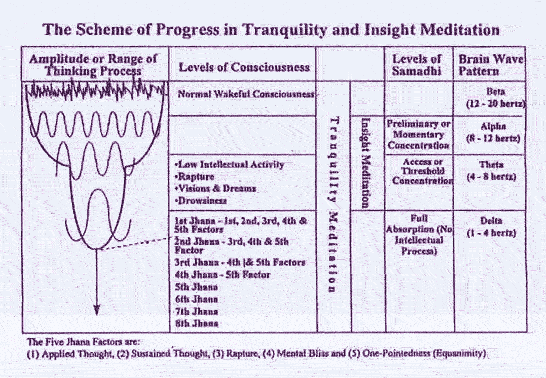|


|
|
|
|
There are forty objects for meditation as quoted in the Buddhist
books. However, not all are suitable for lay people. The best object
is breathing, and this is the method that Buddha used. He was
enlightened with it. It is good, because we can take it wherever we
go. It is there all the time. We can partly control it if we want
to, or we can ignore it, and it becomes entirely automatic.

Beta and Alpha Waves
Looking at the chart, especially in the
column on brain wave patterns (which are obtained from
electro-encephalograms of meditators or people asleep) we notice
that when we first start to meditate most of the patterns are of the
Beta type, i.e. the pattern seen in normal waking consciousness.
When one closes one's eyes and sits in a comfortable position as in
meditation, one will automatically start to obtain Alpha waves in
one's encephalogram. This happens even if one does not concentrate,
but one must not work at any problems. Now when one continues to
concentrate on one's breathing, there will be more Alpha waves
appearing. This means one is deepening the meditation in the
momentary or preliminary concentration. Therefore, from the Beta
pattern of our daily waking consciousness, we can arrive in a short
while to a calm stage of Alpha wave pattern. Of course, this
momentary concentration stage ranges from superficial to very deep
states of Alpha wave pattern. And it is when one is in the Alpha
Wave, that the body starts to relax on its own.
Theta Wave (Access
Concentration)
Now from the deep stage of momentary
concentration, if we continue to concentrate correctly we will slip
into Access concentration with some Theta wave pattern. In this
range of Access concentration, we can stay longer and longer at our
object of meditation, namely breathing. The body is even more
relaxed, and now the mind is also beginning to relax. The mind is
now more even, and not scattered anymore. The brain waves are taller
and fewer, and they are more regular. More and more Theta waves
begin to appear. As one is able to sustain one's concentration on
the breathing, other phenomena begin to set in. In this Access
concentration stage, the following symptoms begin to manifest: (1)
Low intellectual activity (2) Rapture (3)Visions and dreams (4)
Drowsiness
Low intellectual activity
During this relatively deep stage, intellectually one cannot carry
out too difficult a mental sum, e.g. "What is the product of 85
x 397?" or "What is the date of last Wednesday?" In
order to work out these sums, one must go back to Alpha wave or
momentary concentration. Access concentration is when one is just
about to fall asleep or having revelries, and a comfortable feeling
has set in: both in the body and the mind, and the mind is not
interested in any mathematical gymnastics.
Rapture
This phenomenon has a very wide range of manifestations. It starts
with either mild vibrations in one area of the body, or itches as if
insects are biting. Then the vibrations begin to increase in
intensity, and they also become more continuous: so much so that, at
the ultimate stage, they start from the bottom of the spine and move
right up to the top of the head, and then down again along the front
of the face and the chest, abdomen and finally the thighs and the
legs. This process is repeated over and over again. This circular
movement is called the "rotation of the bullock cart" by
the Chinese Taoists. This "rotation of the bullock cart"
is the most healing process in the world: it can even heal the
terminal stages of cancer. Then there are other phenomena like when
the entire body feels extremely heavy, as if one's arms are like
lead, or one has become a huge giant. Or the opposite may occur:
when one has been reduced to the size of a midget. Then one may cry
with tears of bliss, and after this period of ecstasy, one feels
that one has enough love for everybody on earth. There are of
course, other changes and feelings which we will not go into.
Visions and Dreams
In the Access concentration stage, we tend to go into revelries,
dreamlets and dreams. Dreams appear factual and the stories are as
realistic as when we are asleep. Dreamlets are more ephemeral and
they are rather short lived. This progression is much more common
than visions, e.g. seeing Buddha, Jesus or Kuan Yin (Goddess of
Mercy). The danger of the dreamy state is that the meditator tends
to fall asleep. The danger of seeing vision is that the meditator
tends to believe that he is being rewarded for having achieved such
a high plane. One must then use awareness and alertness to prevent
sleep, and humility and wisdom to eradicate pride. During these
revelries and dreamy states, there is a nice sensual feeling about
them, as the body is light and even weightless at times. In this
dreamy and drowsy state there is hardly a care in the world, and
therefore the meditator is lulled by this soft, blissful state, when
sleep becomes an obstacle in his practice.
Drowsiness
This is an inevitable consequence of Theta wave pattern in which
dreams are prevailing. This drowsy, somnolent state with slow brain
waves is fraught with sleepiness. It does not take much to fall
asleep. At this stage, sleepiness is the greatest enemy. We must
then use more awareness and alertness to stay awake. Another
technique is to open one's eyes while meditating. If all this fails,
then go and wash one's face with cold water. During this period of
Access concentration, either few or all the Jhanic (absorption)
factors may appear, but they are present in a rather haphazard
fashion. Sometimes Rapture or at times Sustained thought may
predominate. They do not appear in the right proportions as in the
absorption state. All the absorption states manifest the Delta wave
pattern in their encephalograms. That means from the 1st to the 8th
Jhana it is characterised by the Delta wave pattern.
The Jhanas (the
Absorptions)
We can enter into the Jhanic states only
when we are able to eradicate the five hindrances, namely (1)
Sensual desire (2)Ill-will (3) Sloth and Torpor (4) Restlessness and
Worry (5) Sceptical Doubt.
At the first intimations of the 1st Jhana, there is only a very
swift dip into it. Quite often the meditator does not even know that
he has been in Jhana for those very brief periods of time. Then as
time goes on he is able to stay longer and longer in that Jhanic
state, and it is when all the five Jhanic factors are assembled in
their right proportions that the meditator realises that he is in
Jhana.
The five Jhanic factors are: (1) Applied Thought (2) Sustained
Thought (3) Rapture (4) Mental Bliss (5) One-pointedness with
Equanimity.
Applied thought means the very first application of our
consciousness to the object of meditation. This initial focusing may
not last long. But as our Jhanic concentration improves, we are able
to focus our attention much longer onto the object, and this
prolonged focusing is transformed into Sustained Thought, the 2nd
Jhanic factor.
Now as we go deeper into the 1st Jhana we are able to sustain our
attention onto the object of meditation for long periods of time
without interruption. Thus, applied Thought is no more relevant,
because Sustained Thought has taken over. And as we go deeper still
into the 1st Jhana, higher grades of rapture (five grades have been
described) begin to appear. Mental Bliss is also becoming prominent:
as extraneous or discursive thoughts are reduced and continue to
disappear, Bliss will increasingly take their place. Needless to
say, with the full establishment of Sustained Thought, One-pointedness
concentration begin to be more tenable.
2nd Jhana
Now as one goes towards the 2nd Jhana, any flickering of thoughts is
completely relegated to the background: they do not bother the
meditator at all now, until finally these backdrops of flickering
thoughts are completely eradicated. It becomes quite obvious that
any form of discursive thought must automatically disappear if one
were to descend into the 2nd Jhana. So that when we finally arrive
at the 2nd Jhana, we are left with only Rapture, Bliss and One-pointedness.
Applied and Sustained thoughts must also be dropped. At this point
of time, there is also no more bodily pain.
In the 2nd Jhana, there is only one thought, and that thought is the
object of the meditation, namely "breathing". We are now
approaching one-pointed concentration. As there are now no more
discursive thoughts, the mental stage is upheld by rapture and
bliss. Rapture is now at its peak: one may even bounce up and down
while sitting in the lotus position or the "chi" may
circulate the "bullock cart wheel", as described earlier.
The bouncing has been erroneously called levitation. Whatever it is,
this rapture produces extreme pleasure as well. This peak rapture
would also enhance the mental bliss that is now replacing the
emptiness of thoughts. With this bliss, there is also no room for
mental grief. The peak rapture, bliss and lack of mental grief will
culminate in internal confidence, which was not present before.
Lastly, the absence of thoughts and sound are most conducive to the
unification of mind, which eventually takes place. With this fixity
of the mind, One-pointedness is now stronger, but it is still
diluted by rapture and bliss.
Sleep
When we fall asleep at night, we go through the same sequence of
events as the above: Beta to Delta wave up to the 2nd Jhana.
However, when we are asleep, we are not aware of the stages that we
are travelling through. When we are in dreamless sleep, we are also
in Delta wave, and there is no bodily pain as in the 2nd Jhana. Also
in sleep, we do not bounce as in the 2nd Jhana. The greatest
difference between sleep and meditation is that in the latter case,
we are aware of every stage that we are going through.
3rd Jhana
In the 3rd Jhana, we maybe in a state when we are like a block of
wood and no amount of arousal or beating can wake us up. On the
other hand, when asleep, we can always be awaken up. As one
approaches the 3rd Jhana, one would find that rapture is too coarse,
and therefore it has to be reduced and then completely eradicated
before one could comfortably arrive at the 3rd Jhana. Thus, in the
3rd Jhana, the only Jhanic factors left are mental bliss and one-pointedness.
Having relinquished rapture there is now no more bodily feelings.
That means there are no more bodily pleasure or pain. As there is
now no more bodily function, one cannot also either see or hear. The
yogin may seem to be like a block of wood, but this block of wood
has no feelings at all: you can whack him and he will not be hurt.
The mental bliss and one-pointedness ensure that the meditator is
presently endowed with mindfulness, equanimity and discernment.
These are qualities of the mind. The situation is that there is no
sense of the body at all, and only the mind predominates. Lastly,
even this blissful state has to go. It is not subtle enough for the
4th Jhana. Therefore, bliss must eventually be released in order to
enter the 4th Jhana.
4th Jhana
Finally, we arrive at the last of the fine Material Jhanas. Here we
are left only with the last Jhanic factor of one-pointedness
accompanied by equanimity. Whenever there is only one-pointedness,
it must be associated with its twin ---equanimity. He is totally
absorbed with the breathing: he and the breathing are one. At this
stage, there is neither mental bliss nor grief. There is also no
physical pain or pleasure. There is only specific neutrality: free
from attachment and aversion. And at the very late stage of 4th
Jhana, the yogin may think he is not breathing, but the fact is that
he is breathing, albeit very, very slowly and shallowly. As one
progresses through all the stages of Jhana, one's breathing
automatically becomes shallower and slower until it appears that the
yogin is not breathing, both to himself and to the observer. The
meditator is in this wonderful and rarified state of being: he is
one with the breathing, and if the latter appears to have ceased,
then he believes (wrongly) that he is in Nirvana! You could kill him
for all he cares!
Thus, we have come to the end of the fine Material Jhanas. Up to
now, he is constantly with his object of meditation: breathing or
whatever object he is using. That object(form) is there until the
end of the 4th Jhana. From now onwards, there are no more forms. He
will now enter the formless world: the Four Immaterial Jhanas.
Seeing that hardly any lay people would be able to reach these
states in the privacy of their own homes, these states will be
merely enumerated without elaborating on them. In addition, the Four
Immaterial Jhanas can only be achieved in conditions obtainable in
the monastery. Further, it is also essential to have a master, who
himself is thoroughly acquainted with these formless Jhanas, to
guide one.
The Four Immaterial Jhanas
(Absorptions)
5th Jhana :
The Base of Boundless Space
Still with one-pointedness and equanimity the yogin completely
removes the object of his meditation(breathing, coloured disc etc.)
and pays attention to the space that is left behind.
6th Jhana : The Base of
Boundless Consciousness
By surmounting the object of boundless space, the meditator
withdraws to his own consciousness, which is also boundless.
7th Jhana : The Base of
Nothingness
One must now pay attention to the non-existence, voidness (sunnata)
and secluded aspect of consciousness and space leading eventually to
nothingness.
8th Jhana : The Base of Neither
Perception nor Non-perception
The Yogin on the one hand lacks gross perception, and on the other
hand retains a subtle perception. Although this 8th Jhana is such a
subtle and refined state it is still a mundane state, and it is only
insight that can lead to liberation.
For the sake of completion, the six super-normal powers (Abhinna),
will be tabulated below, but the meditator is discouraged to pursue
these powers for their own sake. The first five Abhinas are still
mundane and do not signify enlightenment. Only the 6th super-normal
power is of supramundane quality. For those yogins who are truly
bent on achieving some form of psychic power, the yogin must be able
to reach the 4th Jhana at will and for a set period of time. For
instance, he sets his mind to be in the 4th Jhana for three hours,
he will remain there for exactly that amount of time, and he will
come out of Jhana when the three hours have expired. He has to will
to acquire one Abhinna at a time until that power is achieved. He
has to fervently will to acquire it before he starts the meditation,
and on the way out also will to achieve it. It may take months or
years to succeed.
(1) Super-normal Feats
(i) One can become many and vice versa
(ii) One can appear and disappear
(iii) One can go through walls and mountains
(iv) One can go in and out of the ground as if it is water
(v) One can walk on water as if it is earth
(vi) One can fly though space
(vii) One can go to the moon and sun
It is almost certain that (iii), (vi) and (vii) are feats as a
result of out-of-body experience (O.B.E.).
(2) Divine Ear :
The yogin can hear sounds of divine origin e.g. admonition or
premonition from his spiritual guides. He can hear sounds and voices
far away as well as sounds of creatures nearby e.g. the noises of
worms in his intestines.
(3) Reading into Other
People's Thoughts :
He can directly tune in to others' thoughts like a radio signal.
Whatever you think, goes into the ether and the receiver just tunes
in.
(4) Recollecting Previous
Lives :
One can recollect details or scenes from one or many previous lives.
(5) Divine Eye
(i) One can see the passing away and rebirth of a being.
(ii) Clairvoyance: knowledge of the future and far away events.
(iii) Knowledge of how one fares after death according to his good
or bad karma.
(6) Destruction of the
Cankers
(i) There is no more sense desire.
(ii) There is no more craving for existence.
(iii) There is no more Ignorance: it is completely replaced by
Wisdom.
(iv) Therefore there are no more wrong views.
This 6th Abhina is the only supramundane one, and when this Abhina
is achieved, then one is enlightened (Arahant).



|
| |
|
|
|
|

